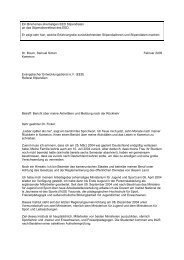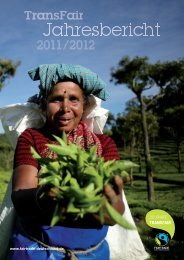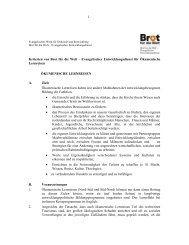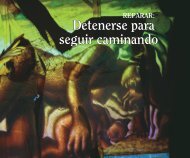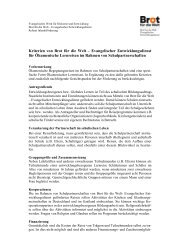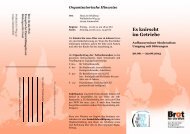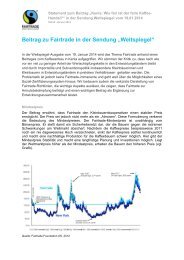Bread for the World & ACT Alliance Discussion ... - Brot für die Welt
Bread for the World & ACT Alliance Discussion ... - Brot für die Welt
Bread for the World & ACT Alliance Discussion ... - Brot für die Welt
- No tags were found...
Create successful ePaper yourself
Turn your PDF publications into a flip-book with our unique Google optimized e-Paper software.
• To ensure that those people being identified in <strong>the</strong> first step, become <strong>the</strong> main<br />
beneficiaries of any fur<strong>the</strong>r action being taken in <strong>the</strong> framework of adaptation, in order<br />
to reduce loss and damage 3 .<br />
Scale and scope, relevance and definition of loss and damage<br />
It is still scientifically impossible to precisely calculate <strong>the</strong> negative effects of climate change.<br />
But empiric data suggest that growing frequency and intensity of extreme wea<strong>the</strong>r events are<br />
leading to higher vulnerability and risks of affected populations, in particular in developing<br />
countries. Most vulnerable are people living in Least Developed Countries, Small Island<br />
Developing States and African countries. In addition, poor and marginalized populations’<br />
lives and livelihoods in climate sensitive regions of o<strong>the</strong>r developing countries could be<br />
affected as well by both, sudden onset and slow onset impacts of climate change. Their<br />
particular risk derives from a combination of high geographical exposure to climate hazards<br />
and relatively weak resilience capacities, including low potential to recover from a climate<br />
induced disaster.<br />
For those high risk groups which have not yet been identified systematically, improved<br />
response measures to reduce risks and to compensate unavoidable loss and damage are<br />
highly relevant, if not a question of survival. Non-action could even threaten <strong>the</strong> realization of<br />
core human rights standards as being enshrined in international human rights law (i.e. <strong>the</strong><br />
Covenants on Civil Political and Economic, Social and Cultural Human Rights).<br />
Subsequently, non-action could be assessed from a legal human rights perspective as a<br />
breach of States’ obligations under <strong>the</strong> Human Rights Covenants.<br />
Given <strong>the</strong> very likely fact that even ambitious mitigation and adaption ef<strong>for</strong>ts will not<br />
hinder unavoidable loss and damage to take place, risk reduction and compensation<br />
need to be developed as a strong pillar within <strong>the</strong> UNFCCC adaptation framework.<br />
Though loss and damage can be substantially limited by mitigation of greenhouse gases, it<br />
still will be significant<br />
There<strong>for</strong>e residual damage needs to be part of those calculations, too. This needs to<br />
be quantified regionally and locally.<br />
A precise definition of loss and damage must be quite encompassing and inclusive taking<br />
into consideration its various aspects: besides direct costs of physical impacts of slow<br />
and sudden onset events it should also include indirect costs e.g. loss of productivity<br />
and livelihoods, social disruption and relocation. It is likewise important to not only<br />
consider public loss (e.g. damage of infrastructure) but also private loss.<br />
Yet, <strong>the</strong>re is no definition of loss and damage being broadly agreed by <strong>the</strong> parties. UN COP<br />
15, however, did offer a reference to loss and damage in AWGLCA which should be taken as<br />
a starting point:<br />
“Social, economic and environmental] loss and damage associated with climate change<br />
impacts in developing countries that are particularly vulnerable to <strong>the</strong> adverse effects of<br />
climate change, including impacts related to extreme wea<strong>the</strong>r events and slow onset events”<br />
(In footnote: Including sea level rise, increasing temperatures, ocean acidification, glacial<br />
3 Para 25<br />
2



